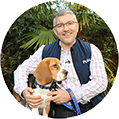Recall training is one of the most important things you can teach your dog. Petplan expert behaviourist Nick Jones shares how to improve your dog’s recall skills in five easy steps.
For successful recall, the reward of returning needs to be more appealing than any distractions. But, for your dog, chasing those squirrels can be pretty tempting. The key is using positive reinforcement training that will have your dog running back to you, every time.
Why is dog recall training important?
From calling your dog back from danger, to telling them that playtime is over, or making sure they don’t chase the local wildlife, recall is one of the most important commands any dog needs to learn. This is easier said than done as it also has to override your dog’s strong natural instincts to run and have fun.
Training this command requires practice and patience, but with the right type of training you can turn it into a fun and mentally stimulating game for your dog. Whether your dog is a puppy and new to recall, or is a bit older and a little rusty on the basics, it’s always a good idea to refresh your training and practise as often as possible.
Finding the right reward
When first training recall, you’ll need to find a high-value treat that your dog can’t resist. For many dogs, this will be food, with some options including a small piece of chicken, dried liver, or a homemade treat. Other dogs may prefer a favourite toy, plenty of cuddles and verbal praise, or a short game. You’ll need to work out what your dog values most, and use this to help them learn that you’re worth listening to, regardless of what else is going on.
How to train your dog to recall
Before you start your training, make sure your dog is on a lead and in a secure, enclosed area like your garden. Then follow these five steps for perfect recall:
- Take one step back from your dog.
- Use a flat hand with the palm towards your dog, and verbally ask them to ‘stay’ at the same time. Avoid using a pointed finger.
- Pause for a few seconds (start with one and work your way up).
- Call your dog back to you using an excited tone of voice. Your body language is also important here, so open your arms at the same time as using your voice.
- When your dog returns to you, reward them with a treat and lots of praise. Gently hold their collar at this point so they’re not tempted to wander off.
During the early stages of training, stay relaxed and concentrate on the first steps. Don’t put too much pressure on, and keep things fun! Once the basics are in place, you can start gradually increasing the distance that you move away from your dog. After that, you can start to increase the amount of time that you ask your dog to stay before calling them to you.
It’s a good idea to keep your dog on a longer lead, especially if you’re in a park or open space. Keep this lead loose and only use it to guide your dog back to you if necessary. With a younger dog, this can be very helpful for reinforcing the recall and making sure they know they need to come back when you call them.
Moving on to advanced skills
A reliable recall means your dog can enjoy running freely while you know they’ll come back to you when called. Maintaining recall skills also needs practice, so make sure you keep this up.
Once your dog has mastered the basic step, you can move onto more advanced techniques including split recall, training in open public spaces off-leash, and in other, more challenging, situations.
Does your dog shoot back to you as soon as you call them? Or could their recall training do with a refresh? Share your training tips with us on social media using #PethoodStories.
